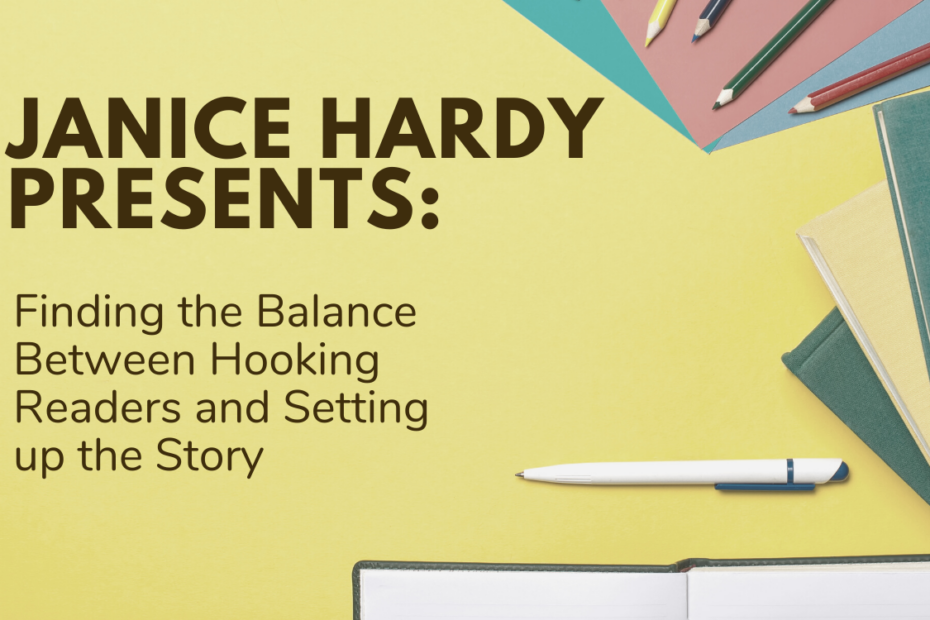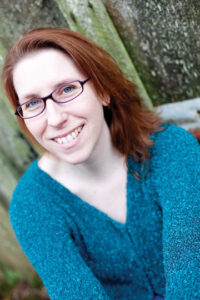Please welcome back author and über blogger Janice Hardy.
There’s a lot of conflicting advice about writing. Common wisdom says to start with a bang and hook your readers right away, while other views say show the protagonist in her ordinary world before it all goes sideways. What really makes this hard is that both are correct. We want to set up our stories and grab our readers at the same time.
The problem with starting with a bang: Since readers haven’t yet met those characters involved in the trouble, they don’t care what’s happening to them.
The problem with starting with setup: Since nothing is going on but introduction of the characters, readers get bored.
For most stories, the plot doesn’t officially start until the inciting event–which could occur as much as fifty pages into the book.
That’s a lot of pages for a reader to slog through if nothing is going on.
The trick here, is to find a “typical day” that’s also fraught with conflict and interesting things going on.
Let’s take a peek at one of my own novel as an example:
In The Shifter, the main plot doesn’t trigger until several chapters into the book. Since it’s a fantasy, I had a lot of world building to establish as well as introduce my protagonist, Nya. It’s exactly the type of writing situation that can sink a writer–a lot of setup needed before the story can start.
So I looked to the world for the answer.
You can setup a novel and provide the hook at the same time if you pick an “everyday moment” from the protagonist’s life that does three things:
1. Shows the inherent conflict of that world (either the world at large or that character’s world).
2. Shows an aspect of the character that will matter to the story.
3. Puts those two things together.
In my case, it looked like this:
1. Shows the inherent conflict of that world (either the world at large or that character’s world).
Nya’s city is under occupation by enemy forces and she’s living on the street, stealing food to survive. The opening scene is her stealing chicken eggs. It shows “life is bad for Nya and here’s why.”
2. Shows an aspect of the character that will matter to the story.
Nya has the unique ability to heal by shifting pain from person to person. If the soldiers occupying her city find out about her, they’ll capture her and use her as a weapon. In the opening scene, she uses this ability. It shows “here’s what Nya can do.”
3. Puts those two things together.
Nya’s egg theft goes wrong and she runs, and in the process, she’s forced to use her ability to heal someone and escape the rancher who wants to arrest her. Readers see her world, her ability, and her morality all in one fell swoop, while they’re wondering if she’ll escape and how this egg theft will turn out. It shows “here’s Nya’s life and the problems she faces because of her ability.”
Not once do I explain how Nya’s ability works. I don’t explain the political situation of the world she lives in. I don’t explain why she’s stealing. It’s classic show, don’t tell, showing all of these things and letting readers figure out how the world works and who Nya is in the process. They can see her ability in action, they can see her world is hard, they can see that she’s stealing to eat.
The hook comes from the setup.
Even though this is an adventure fantasy (and a little easier to create everyday conflict), the same principles apply to any story.
Let’s look at something appropriate to my host site–a romance.
A classic trope in any romance is the meet cute, and probably one of the easier hook/setup combos in the genre (from a grab-the-reader perspective, not the coming up with good ideas aspect). Two nice people meeting in a cute or intriguing way is fun. Romance readers picked up the book to see these two crazy kids fall in love, so they want to see how it all began. Let’s return to those three things:
1. Shows the inherent conflict of that world (either the world at large or that character’s world).
Without action-movie stakes, the conflict here will likely be more personal. He’s afraid of commitment, she’s been hurt one too many times to trust again. She’s a Capulet and he’s Montague. He’s a zombie and she’s alive. Whatever it is, their two “worlds” are keeping them apart.
Quick note about worlds: A world is whatever environment your character lives in. If it’s set in a post office, the post office is the story world. If it takes place in a single room (such as the movie, Closet Land), that room is the story world.
2. Shows an aspect of the character that will matter to the story.
This is how readers get to know the characters. If she’s afraid to trust, we’ll see her being betrayed or acting in a way due to her lack of trust. If she’s from a rival family, we’ll see her interact with her family. If she’s a living person in a zombie world, we’ll see how she deals with zombies. Whatever is important enough about the character to make readers want to read about her will affect the scene in some way.
Quick note about aspects: If this aspect is secret and the reveal isn’t for a long time, obviously you don’t have to put it front and center. But you might look for ways to show how it affects the character’s life, or a hint that there’s more going on here than readers see.
3. Puts those two things together.
The conflict of the world will be the problem the protagonist is dealing with in the opening scene. She’ll use or show whatever important aspect about her is vital to her character. If she has trust issues, perhaps show her on a blind date, waiting outside the restaurant trying to decide if the guy looks shifty or not. If she’s from a rival family, show her and her family having a problem with that rival family. If he’s a zombie, show his zombiness causing her trouble.
Quick note about togetherness: Look for situations that will in some way lead to whatever the core conflict of your novel is. A great opening scene that has zero to do with the story just creates a situation where you have two actual openings–one that hooks readers, and then one that starts the story. If they’re both great “openings” you’ll probably be fine, but if the real opening is all setup and no hook (common with “great hook” openings that don’t connect to the story), you risk readers getting bored and setting the book down when they hit that slow setup scene.
Setting up the story and hooking readers is all about showing them why they should read your book. The opening is either the reason the story is happening, or something that nudges the protagonist toward that reason. But either way, it’s a compelling character, in a compelling world, facing a compelling problem.

